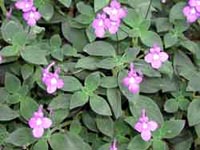Resource Library
Plant of the Week: Streptocarpella
The University of Arkansas System Division of Agriculture does not promote, support or recommend plants featured in "Plant of the Week." Please consult your local Extension office for plants suitable for your region.
Plant of the Week
Streptocarpella
Latin: Streptocarpella saxorum

When the group of nursery, greenhouse and University professionals got together to select the Arkansas Select plants for 2002, there was unanimous agreement that everyone liked the plant but hated the name. Streptocarpella saxorum does not have a common name, but don’t let a tongue-twisting dissuade you from trying this interesting relative of the African violet. Pronounce it Strep - toe - car - pella.
Streptocarpella is a small, tender basket plant from southern Africa that quickly grows to eight inches tall with a spread of 12 inches across. It branches freely and produces soft, velvety green leaves that are about two inches long.
From nodes along the stem the plant produces an array of slender, almost wiry, four inch long scapes which terminate in three to five flowers which gracefully float above the foliage. The flowers are an inch long with a narrow tube which splays out at the end into a slanted, pansy-like face with five lobes. The most common color is purple, but various shades of lighter blue are sometimes encountered.
Some references list Streptocarpella as a selection of Streptocarpus, but these two groups of plants are considerably different. While the flowers of Streptocarpus and Streptocarpella are similar, the plant habit is considerably different. Streptocarpus grows in a basal whorl of leaves with no above-ground branching while Streptocarpella has a well branched top.
The translation of the Latin name means "Streptocarpus like". The name Streptocarpus means "twisted fruit", a reference to the slender, twisted seed capsule that the plants produce. Streptocarpella produces a twisted seed pod but it is only about an inch long, not eight or more
inches long as seen in Streptocarpus. The epitaph "saxorum" indicates that in the wild the plant grows amongst the rocks, most likely suspended from crevices in a rock cliff.
The Arkansas Select program is an effort by the Arkansas Green Industry Association and University of Arkansas horticulturists to introduce Arkansas gardeners to new and well adapted plants for their garden. This year the program has highlighted five plants for the program. For a complete list of the plants designated as Arkansas Select winners since the program began in 1998, visit the Arkansas Cooperative Extension Service website at
Members of the African violet family often have a finicky reputation, but this plant didn’t get the message. It is the easiest to grow of any gesneriad I have thus far attempted. Most members of the African violet family succumb in our greenhouse in the winter to the cold water, but this plant tolerates even this insult to its tropical nature. Our plants have shown some of the yellow spotting associated with cold water damage, but they tolerate the insult without a fuss.
Streptocarpella should be grown in a well drained, organic potting mix in either a hanging basket, window box or decorative container. While not a heavy feeder, it should be fertilized periodically to keep it growing and flowering. It is best situated in a bright location where it gets good light but not direct sun. Like all gesneriads it should have uniformly moist conditions.
This plant not only will perform well on the patio or porch during the summer months, it will continue to bloom all winter long as a houseplant. In the winter give it an east or south window to assure it gets enough light to continue blooming. It is easy to propagate by terminal cuttings.
By: Gerald Klingaman, retired
Extension Horticulturist - Ornamentals
Extension News - May 10, 2002
The University of Arkansas System Division of Agriculture does not maintain lists of retail outlets where these plants can be purchased. Please check your local nursery or other retail outlets to ask about the availability of these plants for your growing area.